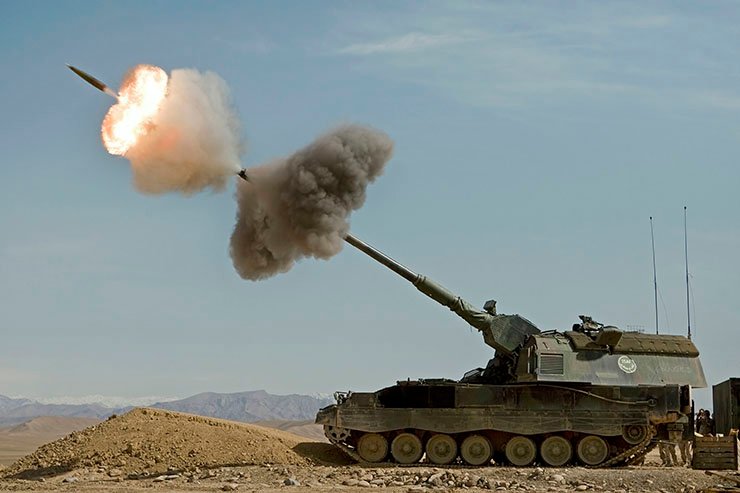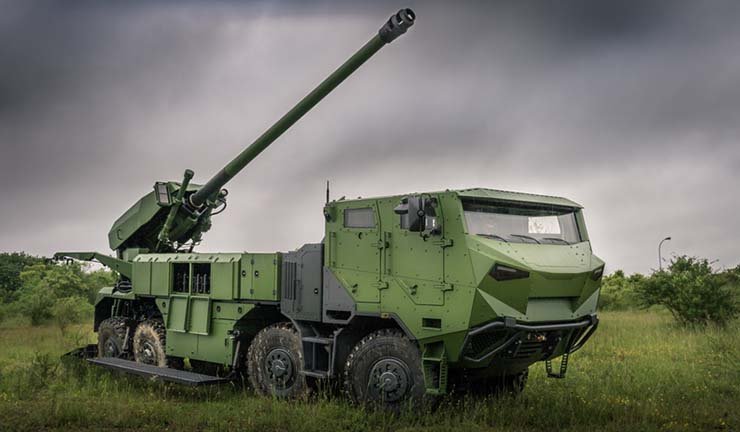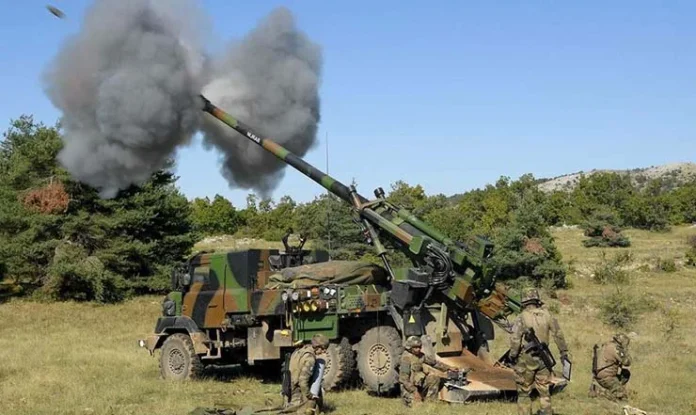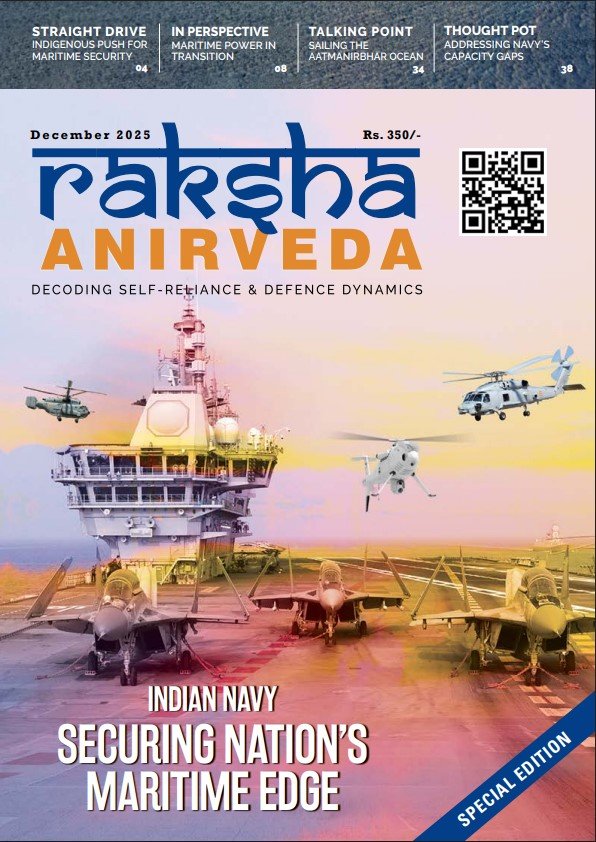Ukraine places artillery once again at the centre of the battlefield
The war in Ukraine is showing the return of a military term that had slowly faded from strategic thinking over the decades: attrition. In recent operations, military lingo revolved around the catch-phrases “boots on the ground”, or “winning hearts and minds”. Ukraine is holding on better than expected, thanks to massive international support against the Russian military machine, using artillery in its most traditional form: defending sectors with brute firepower.
With the arrival of French Caesar howitzers in Ukraine, and its far-reaching and accurate capacities, Ukrainians are able to put some scare into the Russians and foil their initial plans, despite Russian progress. Combined with remarkable drone operation, Ukrainians have been using artillery effectively, turning Russia’s dream of a quick win into more of a challenging and protracted struggle.
Russia fields hundreds of howitzers, mainly with 1980s technology. So how does Ukraine hold the front with a hugely inferior number of artillery units? The answer is simple: Ukrainians are using the most advanced artillery systems in the world, while Russia’s units are considerably less efficient. Analyst Lisa Seligman reports: “The French are also providing the truck-mounted CAESAR howitzers, which are more mobile than the towed Russian artillery and can move quickly to evade Russian counterfire. “The way you deal with Russian artillery is: you kill it,” Johnson said. “Anything that enables [the Ukrainians] to stay competitive in the artillery fight, to start to whittle away at Russian artillery, prevents the Russians from doing what they are trying to do, which is take ground.”
Germany and the Netherlands have already donated 12 Pzh 2000 self-propelled howitzers to Ukraine, and have pledged more. The German cannon is superior to the Russian counterpart in virtually every dimension: longer range, a broader choice of ammunition, better accuracy, etc. More specifically, the PzH 2000 is able to fire standard shells, but also rocket-assisted shells, and Excalibur shells – a new generation with over-50km range and under-5-metre precision.

But even the PzH, recognised as one of the best artillery systems in the world, has limitations, which matter on the modern battlefield. Its weight makes it both hard to move on the ground and slow to deploy. And its design makes it extremely expensive, which means fewer units can fit into a given military budget. Enter the Caesar.
Nexter Caesar stealing the show
The need for artillery, which is both more deployable and more mobile, has been recognised for many decades – but the technology and the products were simply not available.
The French surprised observers when they produced the Caesar self-propelled howitzer, fitting a modern firing system onto a 6×6 or 8×8 all-road truck platform. The French artillery vehicle bases its survivability on its agility, and not on tons of armour. It is able to deploy, fire six high-precision shells up to 42 km, and relocate, all under 3 minutes – thus denying the enemy any window of opportunity to fire back. The Caesar truck was deployed in Iraq, Afghanistan, Mali
The revelation of Caesar seems to have occurred during the Iraq deployment. Colonel Oliver Fort writes how the US army admired the French gun’s precision, range, mobility and reliability, when it was deployed in 2018: “it is a good time to take a look at the platform’s most demanding operation in Iraq from 2016 to 2019. CAESAR is the only 155 mm 52 Cal gun in the world to have fired more than 70% of 19,000 rounds above charge 5 and 6 in high temperatures often close to 50°C. In doing this, Caesar consistently achieved very high accuracy (the US artillerymen qualified it as a near precision artillery system, when in fact it was only firing unguided munitions).”
For the first time, self-propelled howitzers could be used in counter-insurgency settings, where accuracy is key to striking targets within urban areas while avoiding civilian casualties. The US Army has since included truck-mounted artillery in requests for proposals, and advised the Iraqi Army to purchase the Caesar which performed so well in their environment.

Modern warfare brings together systematically asymmetric or dissymmetric forces. In such settings, older-generation artillery is simply useless: enemy units will systematically evade them and they know it. In a nutshell, things happen far faster on today’s battlefield, than they would have 40 years ago in a Cold War configuration.
Caesar brings both advantages to the table
Caesar trucks were keenly observed in recent operations: Operation Chammal in Syria, where it served against the Islamic State, Iraq, and Afghanistan. In all cases, they were able to strike accurately and swiftly, any detectable enemy unit – something that was simply not possible with other types of older howitzers.
The European Defence Review writes that “The CAESAR combines the high mobility of a truck with the power of a 155mm 52 calibre gun. It is the only long-range proven 52 calibre in the world with 70% of the ammunition fired in combat missions in Irak (above 18.000) in maximum charges, with very high accuracy and crew safety performances. In addition, it demonstrates unrivalled mobility as this 18-ton system is air transportable in Lockheed C130 and can be adapted to any road, with limited impact on supply.”

The truck can easily be transported by military cargo planes, such as the Hercules, IL76, C-17 Globemaster and Europe’s flagship, the A400M, as it was during the Barkhane operation in Africa.
In addition, the Caesar gun fires all of the modern shells, which its counterparts such as the PzH2000, can shoot but also the proprietary Bonus/Bofors
Nexter’s Caesar did well on its baptisms of fire, against smaller armies and ultra-mobile enemy groups. It is showing itself again to be deadly against a large conventional force such as Russia’s. This indicates a turning point in tactics and rapid obsolescence of existing artillery forces. On the battlefield, firepower is nothing without survivability. And thick layers of armour simply do not provide it anymore. Caesar trucks are now central units on the battlefield and have blurred the line between melee and support units.
– The writer is a defence and security industry consultant having varied experience working with medium and large companies majorly in European market. The views expressed are personal and do not necessarily reflect the views of Raksha Anirveda
–The writer is a defence and security industry consultant with varied experience of working with medium and large companies majorly in European market. The views expressed are of the writer and do not necessarily reflect the views of Raksha Anirveda





